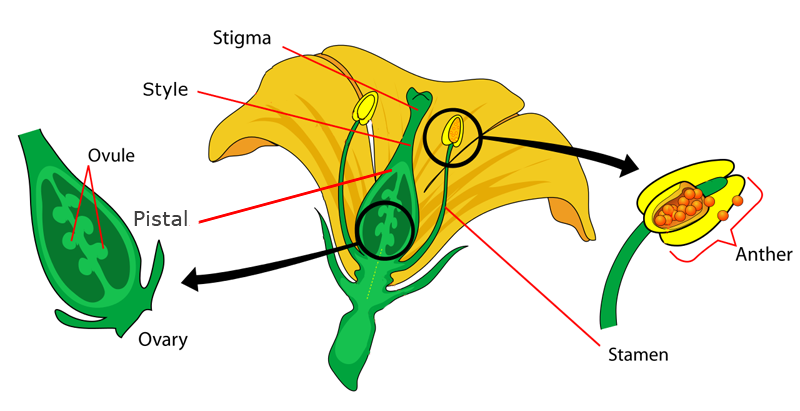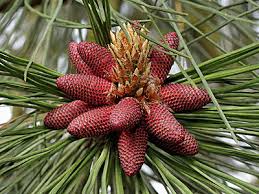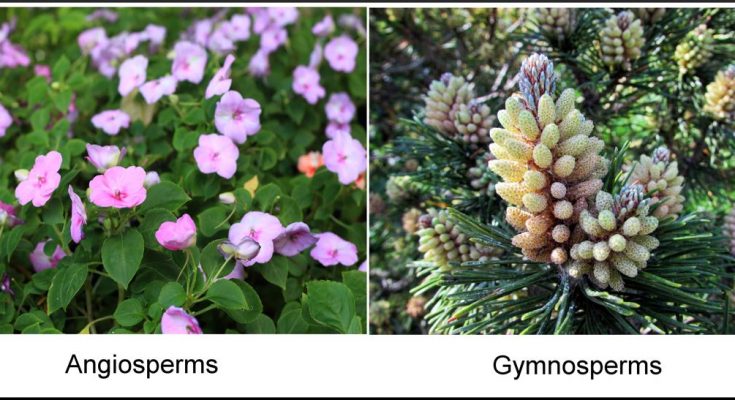Angiosperms and Gymnosperms are two major types of seed-producing plants.
Angiosperms, commonly known as flowering plants, produce seeds that are enclosed within an ovary. This ovary later develops into a fruit following fertilisation. These plants generally follow a seasonal life cycle and typically have flat-shaped leaves. Examples of Angiosperms include various fruit trees such as mango, apple, banana, peach, cherry, orange, and pear; grains like rice, corn, and wheat; and other plants like roses, lilies, broccoli, kale, petunias, eggplant, tomatoes, peppers, and sugarcanes.
Gymnosperms, on the other hand, are often referred to as non-flowering plants. They produce seeds that are not enclosed by an ovary but are instead exposed on structures called sporophylls. Gymnosperms are usually evergreen, meaning they retain their leaves throughout the year, and the leaves are typically scale-like or needle-like. Examples of Gymnosperms include pines, spruces, firs, cypresses, junipers, redwoods, ginkgo, and cycads.
Table of Contents
Differences Between Angiosperms and Gymnosperms in tabular format
| Aspect | Angiosperms | Gymnosperms | |
|---|---|---|---|
| 1 | Nature of Plants | Flowering plants whose seeds are enclosed in fruits. | Non-flowering plants with naked seeds typically found on scales or as cones. |
| 2 | Seed Enclosure | Seeds enclosed within an ovary. | Seeds unenclosed or naked. |
| 3 | Life Cycle | Seasonal lifecycle, adapting to seasons. | Predominantly evergreen, maintaining foliage throughout the year. |
| 4 | Leaf Morphology | Leaves are broad and flat, maximising photosynthesis. | Leaves are scale-like or needle-like, minimising water loss. |
| 5 | Wood Type | Produce hardwood, used in furniture, flooring, and construction. | Produce softwood, used in paper production and construction. |
| 6 | Reproductive System | Reproductive organs are flowers (unisexual or bisexual), using animals and wind for pollination. | Reproductive organs are cones (unisexual), primarily relying on wind for pollination. |
| 7 | Xylem Structure | Contains vessels and tracheids, facilitating efficient water transport. | Mainly consists of tracheids and lacks true vessels. |
| 8 | Phloem Structure | Contains companion cells that aid in nutrient transport. | Lacks companion cells, has albuminous cells assisting in sugar transport. |
| 9 | Diversity and Adaptation | Greater diversity, adapted to various terrestrial ecosystems. | Fewer species, limited by the lack of protective seed cover. |
| 10 | Utilisation | Widely used in food, medicine, clothing, and more. | Mainly used in paper and lumber production. |
| 11 | Examples | Includes fruit trees, grains, vegetables, shrubs, grasses, and flowers. | Includes pines, spruces, ginkgo, cycads, cypresses, junipers, and redwoods, characterised by naked seeds and evergreen nature. |
 |  |
Also Check – Angiosperms- Characteristics, Classification, and Reproductive Biology
Difference Between Angiosperms and Gymnosperms Explained in Details
Difference Between Angiosperms and Gymnosperms in terms of Nature of Plants
- Angiosperms- These are flowering plants, and a distinctive feature is that their seeds are enclosed within fruits. The fruit develops from the ovary after pollination and fertilisation of flowers. Fruits protect the developing seeds and can aid in their dispersal, carried away by animals or other ecological agents.
- Gymnosperms- Unlike angiosperms, gymnosperms do not produce flowers. Instead, they bear seeds directly on the surfaces of cones or scales. These seeds are exposed, which is why they are often referred to as “naked seeds.” The cones or scales are typically woody and help in the dispersal of seeds mainly through wind.
Difference Between Angiosperms and Gymnosperms in terms of Seed Enclosure
- Angiosperms- The seeds are enclosed within an ovary, which is a part of the flower. This ovary later develops into a fruit, which encases the seeds, providing protection from environmental factors and aiding in dispersal mechanisms.
- Gymnosperms- The seeds are not enclosed by an ovary but are naked and often exposed on cone scales. This lack of a protective fruit or ovary means that gymnosperm seeds rely more heavily on other dispersal methods, primarily wind.
Difference Between Angiosperms and Gymnosperms in terms of Life Cycle


- Angiosperms- They typically have a seasonal lifecycle, meaning they go through different stages of growth, flowering, and dormancy depending on the season. This adaptability allows angiosperms to thrive in a variety of environments and conditions.
- Gymnosperms- Most gymnosperms are evergreen, maintaining their foliage throughout the year. This characteristic allows them to photosynthesize year-round, which is particularly advantageous in cooler or nutrient-poor environments where growing seasons are short.
Also Check – Functional and morphological evolution in gymnosperms
Difference Between Angiosperms and Gymnosperms in terms of Leaf Morphology
- Angiosperms- The leaves of angiosperms are generally broad and flat, which increases the surface area exposed to sunlight, maximising photosynthesis. This leaf structure is well-suited to environments where light is abundant and water is relatively available.
- Gymnosperms- Their leaves are typically scale-like or needle-like, which reduces the surface area and minimises water loss. This adaptation is particularly useful in arid or cold environments, reducing the risk of water loss through transpiration.
Difference Between Angiosperms and Gymnosperms in terms of Wood Type
- Angiosperms- They generally produce hardwood, which is denser and often used in making furniture, flooring, and for construction purposes. Hardwood from angiosperms tends to have a more complex structure with vessels that allow for efficient water and nutrient transport.
- Gymnosperms- Typically, these plants produce softwood, which is lighter and often used in paper production, construction, and as lumber. Softwood lacks the vessels found in hardwood, consisting mainly of tracheids that transport water and support the plant structure.
Also Check – The rise of angiosperms pushed conifers to decline during global cooling
Difference Between Angiosperms and Gymnosperms in terms of Reproductive System
- Angiosperms- Their reproductive organs are flowers, which can be either unisexual (having either male or female organs) or bisexual (having both male and female organs). Flowers are often brightly coloured and fragrant to attract pollinators such as insects, birds, and mammals, though some angiosperms also rely on wind for pollination. This adaptation enhances the efficiency of pollen transfer.
- Gymnosperms- Their reproductive structures are cones, which are generally unisexual. Pollination primarily occurs through wind, which carries pollen from male cones to female cones. This method is less targeted than biotic pollination and can be less efficient as it relies on the chance dispersal of pollen through air currents.
Also Check – Why is Double Fertilization in Gymnosperms absent ?
Difference Between Angiosperms and Gymnosperms in terms of Xylem Structure
- Angiosperms- The xylem in angiosperms contains both vessels and tracheids. Vessels are wider and shorter cells that allow for more efficient water and nutrient transport throughout the plant, which supports higher metabolic rates and growth speeds.
- Gymnosperms- The xylem primarily consists of tracheids, which are narrower and longer cells than vessels. They lack true vessels, which generally makes water transport less efficient compared to angiosperms. However, tracheids also provide structural support and are well-suited to colder climates where the risk of air embolisms in vessels can be high.
Difference Between Angiosperms and Gymnosperms in terms of Phloem Structure
- Angiosperms- The phloem in angiosperms includes companion cells alongside sieve elements. Companion cells are crucial for the loading and unloading of sugars and other metabolic products into the sieve tubes, facilitating effective nutrient distribution throughout the plant.
- Gymnosperms- Instead of companion cells, gymnosperms have albuminous cells which perform a similar role in assisting the transport of sugars. These albuminous cells are structurally and functionally different from companion cells and are an adaptation to the gymnosperms’ simpler overall structure.
Also Check – Also Check – Gymnosperm Life Cycle with Pine Tree Example
Difference Between Angiosperms and Gymnosperms in terms of Diversity and Adaptation
- Angiosperms- They exhibit greater diversity, with over 300,000 known species adapted to a wide range of terrestrial ecosystems. This diversity is partly due to their advanced reproductive strategies, such as flowers and fruits that help in successful pollination and seed dispersal.
- Gymnosperms- Have fewer species compared to angiosperms, largely because their reproductive structures and strategies are less varied and less protected. Their seeds’ lack of protective enclosures also limits their dispersal and survival capabilities, confining them to fewer ecological niches.
Difference Between Angiosperms and Gymnosperms in terms of Utilisation
- Angiosperms- These plants are used extensively across many aspects of human life, providing food (fruits, vegetables, grains), medicine (many medicinal compounds are derived from angiosperms), and materials for clothing (like cotton). Their diverse forms and the substances they produce make them integral to economies and cultures worldwide.
- Gymnosperms- Typically used in industries such as paper and lumber. Softwood from gymnosperms is a major material in construction and paper manufacturing due to its relative abundance and ease of processing compared to hardwood.
Frequently Asked Questions & Answers on Angiosperms and Gymnosperms
Describe the nature of plants in Angiosperms and Gymnosperms. How do their reproductive strategies differ?
- Answer- Angiosperms are flowering plants with seeds enclosed in fruits developed from ovaries post-pollination. They use colourful and fragrant flowers to attract various pollinators. Gymnosperms do not produce flowers but have seeds on the surfaces of cones, relying mainly on wind for pollination.
Explain the significance of seed enclosure in Angiosperms and Gymnosperms and its ecological implications.
- Answer- In Angiosperms, seeds are protected within an ovary that becomes a fruit, aiding in dispersal and providing a survival advantage. In contrast, Gymnosperms have naked seeds on cones, which are more exposed and rely heavily on wind for dispersal, limiting their ecological niches.
How does the life cycle of Angiosperms compare to that of Gymnosperms?
- Answer- Angiosperms have a seasonal lifecycle, adapting their growth and reproductive phases to the seasons, which allows them to thrive in diverse environments. Gymnosperms are mostly evergreen, maintaining their foliage year-round, which is beneficial in cooler or nutrient-poor environments.
Discuss the differences in leaf morphology between Angiosperms and Gymnosperms and the environmental adaptations these differences suggest.
- Answer- Angiosperms have broad, flat leaves that maximise sunlight absorption and photosynthesis, ideal for environments with ample light and water. Gymnosperms have scale-like or needle-like leaves that minimise water loss, suited to arid or cold environments.
Compare the wood types produced by Angiosperms and Gymnosperms and their typical uses.
- Answer- Angiosperms produce dense hardwood used in furniture and construction, featuring vessels for efficient nutrient transport. Gymnosperms produce lighter softwood, primarily used in paper production and construction, consisting mainly of tracheids for structural support.
Explain how the structure of xylem and phloem differs between Angiosperms and Gymnosperms and the functional implications of these differences.
- Answer- Angiosperm xylem includes both vessels and tracheids for efficient water transport, supporting higher growth rates. Their phloem contains companion cells for effective nutrient distribution. Gymnosperm xylem lacks vessels and uses tracheids, which are less efficient but prevent air embolisms. Their phloem lacks companion cells and instead uses albuminous cells for sugar transport.
Discuss the diversity and ecological adaptations of Angiosperms compared to Gymnosperms.
- Answer- Angiosperms exhibit greater diversity with adaptations that include flowers and fruits for successful pollination and seed dispersal. Gymnosperms have fewer species, largely due to simpler reproductive structures and unprotected seeds, which limit their dispersal and survival.
How are Angiosperms and Gymnosperms utilised differently in human economic activities?
- Answer- Angiosperms are extensively used in food production, medicine, and clothing, contributing significantly to various industries due to their diverse forms and products. Gymnosperms are mainly used in the paper and lumber industries, where their softwood is valued for its ease of processing and abundance.

